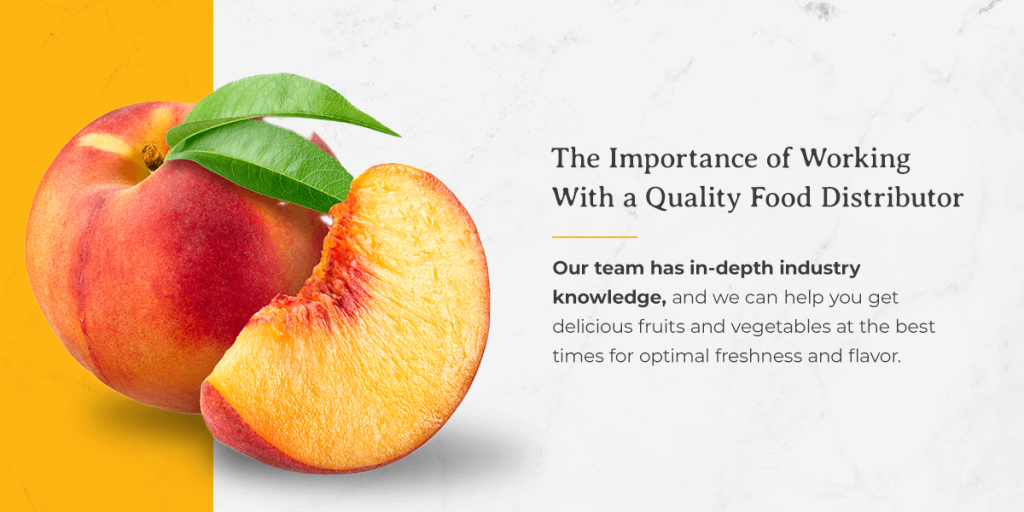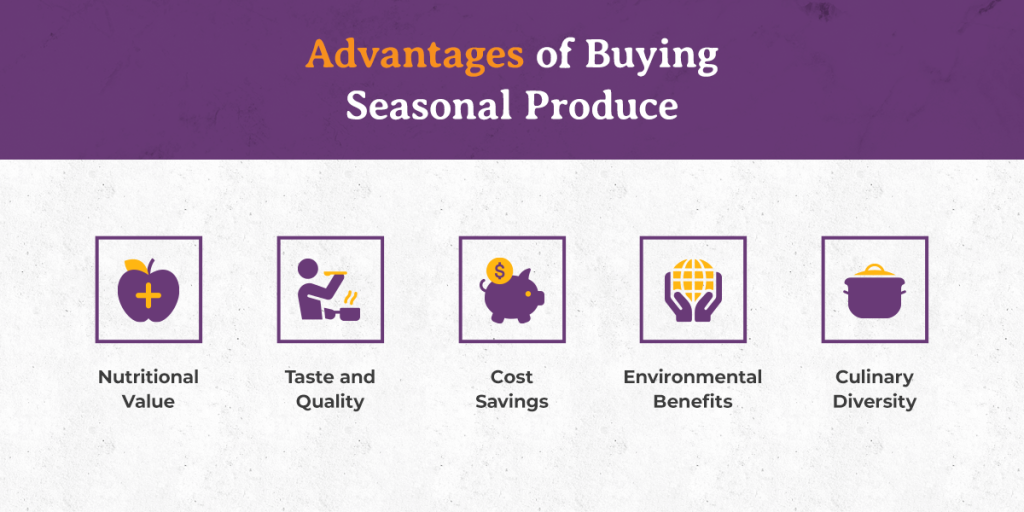Feeser’s In-Season Produce Guide
For businesses that invest in food products, knowing what produce is in season can be highly advantageous for providing the best quality dishes. Various fruits and vegetables thrive at different times throughout the year according to their unique natural growth cycles. Eating according to the season is one of the best ways to keep meals interesting and enjoy the highest quality products.
Discover more about the advantages of buying fruits and vegetables in their prime and the availability of popular options in Pennsylvania with this in-season produce guide.

Advantages of Buying Seasonal Produce
Whether your business serves customers, students, patients or workers, buying seasonal fruits and vegetables can enhance your overall food offerings and benefit your reputation. Explore the key reasons to choose in-season produce below.
Nutritional Value
A major benefit of seasonal produce is its higher nutritional value. The longer these foods mature on their plant, the more nutrient-dense they become. In-season produce can grow to its peak ripeness, allowing each piece to become a healthier, more delicious snack or ingredient.
Fresh, in-season fruits and vegetables are a healthier choice for consumers, allowing them to enjoy more nourishment with each bite. If your organization — particularly health care facilities or schools — wants to offer better food options to support the health and well-being of those who rely on your kitchen, then choosing seasonal options is an excellent way to improve your menu.
Taste and Quality
Taste is a key reason why choosing in-season fruits and vegetables is best. These foods are grown to peak flavor development, meaning they have optimal sugar content and acidity when it’s time to consume. Those enjoying the produce will appreciate its outstanding quality and taste profile.
You can expect better flavor from seasonal produce, especially if it is grown in your region and doesn’t require long travel. In-season options are typically higher quality, fresher and more delicious than out-of-season plants that rely on artificial growing practices or require long-distance shipping.
Cost Savings
In-season produce is also a worthwhile choice financially. Buying seasonal fruits and vegetables grown relatively close to your region can lead to cost savings for a few reasons. You don’t have to account for long-distance travel expenses. In-season foods do not involve specialty growing methods that require additional labor or energy demands. These products also have less stringent storage needs and can last longer, supporting reduced waste that saves your organization money in the long run.
Fresh, seasonal produce is often sold at lower prices and is an economically sound decision for your business.
Environmental Benefits
Growing in-season fruits and vegetables is also better for the environment. Seasonal options require fewer resources than out-of-season produce, including less water, land and chemical pesticides or fertilizers.
You can also feel good about your choice because buying in-season produce contributes to a smaller carbon footprint. Shorter transportation routes mean less fuel consumption and lower greenhouse gas emissions.
Fresher, better-tasting produce is more likely to be eaten, helping your business reduce food waste and supporting a healthier environment.
Culinary Diversity
Another advantage of choosing in-season fruits and vegetables is encouraging experimentation in your business’s kitchen. Seasonal ingredients can help your team maintain a fresh, interesting menu with different dishes. Embracing various fruits and vegetables can inspire creativity — you may find new best-sellers or fan favorites.
Your kitchen team can swap out ingredients in staple dishes or offer limited-time specials that change with the season. Trying out diverse produce throughout the year keeps your offerings exciting and allows your organization to embrace healthier, more nutritious options.
Pennsylvania Seasonal Produce Guide
Location greatly influences when certain types of fruits and vegetables are in season. Pennsylvania has a particularly great habitat for agriculture with its temperate climate, rich soil and long growing seasons. These factors enable robust options from January to December. Understanding seasonal produce availability can help local organizations get the most delicious and high-quality options no matter the month.
Learn more about the best times to get different fruits and vegetables for your business in this seasonal produce guide for Pennsylvania.
In-Season Fruit Availability in Pennsylvania
Peaches, apples and grapes are some of the most popular fruit varieties in Pennsylvania. Whether enjoyed as a snack or as part of a recipe, fruits are a sweet yet nourishing option. Everyone, from those recovering from surgery to students eating lunch at school, can enjoy sinking their teeth into every flavorful bite.
Explore the following types of fruit and when they are readily available in Pennsylvania:
- Strawberries: Mid-March to mid-June
- Apples: Mid-August to mid-March
- Grapes: Mid-May to mid-September
- Peaches: Mid-May to mid-August
- Raspberries: Mid-May to mid-August
- Tomatoes: Mid-May to mid-September
- Cucumber: Mid-May to mid-September
- Eggplant: Mid-May to mid-September
- Peppers: Mid-May to mid-September
- Zucchini: Mid-May to mid-September
- Corn: Mid-May to mid-September
In-Season Vegetable Availability in Pennsylvania
Pennsylvania is known for a few different vegetables, from potatoes to tomatoes, but you can find many interesting options for your business. Below are popular vegetables and their peak availability in the Keystone State:
- Asparagus: Mid-April to mid-August
- Beets: Mid-August to mid-March
- Broccoli: Mid-April to mid-August
- Cabbage: Mid-August to mid-March
- Carrots: Mid-August to mid-March
- Cauliflower: Mid-April to mid-August
- Lettuce: Mid-August to mid-March
- Onions: Mid-August to mid-March
- Pumpkins: Mid-June to mid-September
- Radishes: Mid-January to mid-April and mid-August to mid-November
- Spinach: Mid-August to mid-March
A few vegetables are readily available all year long in Pennsylvania. These include mushrooms, potatoes and garlic.
The Importance of Working With a Quality Food Distributor
The best way to enjoy fresh produce throughout the year is by partnering with a leading food distributor like Feeser’s. Our team has in-depth industry knowledge, and we can help you get delicious fruits and vegetables at the best times for optimal freshness and flavor.
We have offered produce distribution to businesses throughout Central Pennsylvania and the Mid-Atlantic region for over a century. Count on us to prioritize quality and deliver the best food products all year long. In addition to produce, we provide fresh-cut meats, frozen foods, dairy, seafood and more for customers — we can tailor our services to meet your unique needs.

Trust Feeser’s Food Distributors to Help You Navigate Seasonal Produce Today
As one of the Mid-Atlantic’s leading wholesale produce distributors, Feeser’s Food Distributors proudly offers a variety of high-quality fruit and vegetable options. For over 100 years, we’ve provided our customers with delicious, fresh foods to enhance kitchen operations.
Our team can help you get the products you need and share insights on what produce is in season now to support peak flavor and ripeness. We also have a selection of pre-cut, ready-to-use fruits and vegetables and specialty produce, including options like microgreens and edible flowers, available.
Partner with us for top-quality produce options delivered right to your business.

